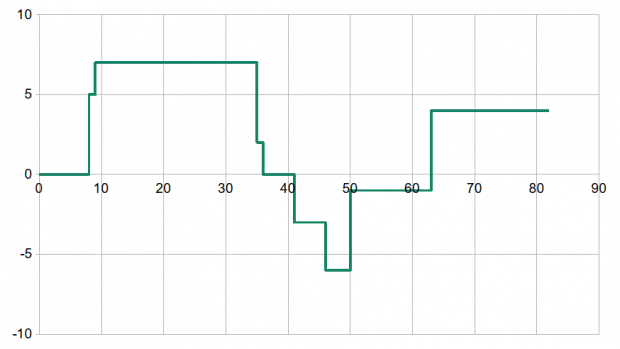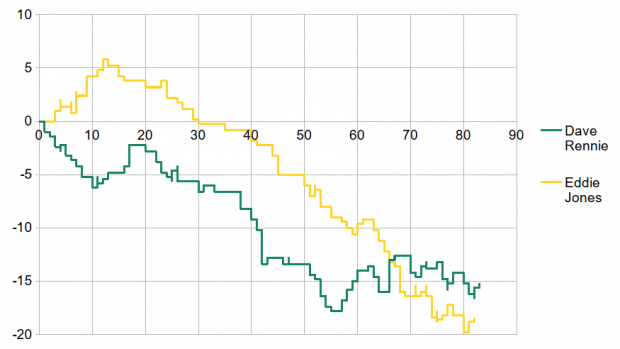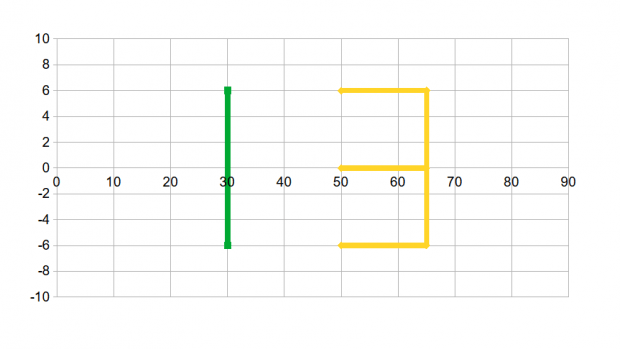The 13 Minute Team?

Readers might have seen charts like the above one applied to various codes of football. They are something like a cricket “worm” chart. The one above shows the points margin of the weekend’s Ireland-Samoa match vs time through the match. The vertical axis is the Irish winning margin, which can be negative if Ireland is loosing, and the horizontal axis is match time in minutes.
Following the green line from left to right, Ireland’s margin is 0 at the start of the match. At 8 minutes Ireland scores a try, and then one minute later converts, bringing the margin up to 7 points. At 35 minutes Samoa scores a try and converts one minute later, bringing the margin back to 0. Then at 41 minutes Samoa scores a penalty, taking the Irish margin down to -3. After another penalty and two tries, Ireland gets to a margin of 4 points at 63 minutes and there the margin stays till the end.
It is possible to average the charts of a team over multiple matches, and sometimes patterns appear. The following chart shows the average of the Wallabies under Eddie Jones, compared to a similar average for the Wallabies under Dave Rennie.

The gold line is the average chart for all 5 of Eddie’s matches in his most recent stint as coach of the Wallabies. The green line is the average chart for the most recent 2022 Wallabies matches against the same opponents (1 x France, 2 x All Blacks, 1 x Springboks, and 1x Argentina) under Dave Rennie. So, the same set of opponents but in consecutive years.
What can we see? Under Eddie Jones the wallabies are often world beaters for the first 13 minutes of their matches. From thereon out, it’s an increasingly steep downward slope to an average loosing margin of 18.4 points.
Under Dave Rennie, the average start was about as poor as Eddie’s is good, but there was commonly a fightback from 10-20 minutes, followed by a similar decline to 55 minutes, where the last 25 minutes were won more often than not by the Wallabies. The end result was an average loss of 15.2 points.
In a way, the match patterns are opposites – Eddie with a good start, Rennie with a strong finish.
What are the possible causes? Some things that come to mind to explain a consistently good start followed by a consistent decline include the following:
- A hyped up motivated team for which the hype wears off or otherwise can’t be sustained.
- A big team or a big pack lacking in stamina that can’t maintain its initial work rate.
- Match plans that opponents work out after 15 minutes.
There are also probably explanations I haven’t thought of.
And what explains Dave Rennie’s line? Was his match plan reactionary – waiting to see what the opponents did and then the team reacted, or trying to outlast opponents with Michael Hooper playing full on to the very end?
It seems that neither worked well enough, but what can Eddie do?
If it is hype, I’d guess there is a limit to how much you can gee up a team. It is only working for 13 minutes at the moment, and the amount of geeing up you would need to do to last 80 minutes might cause lasting damage to, I don’t know what – singe the players jerseys or melt their faces or something.
If the team is too big and lacking in stamina, I doubt you can change the mix of fast twitch and slow twitch muscle fibres in the forwards’ legs in two or three weeks. It took Will Skelton a year or two to become a less heavy and more durable player. Leg transplants? I think we’re out of luck there given two weeks. Pete Samu and Michael Hooper back in the team – doable. An 8-0 bench? the Springboks had a 7-1 bench on the weekend. I guess they wanted to give a lot of forwards a run, but maybe that might help us a bit.
If opponents are working out the match plans in 15 minutes, perhaps something more tricky might save the day. Eddie can surely come up with something. But what? It has to be original enough that no one will see it coming, but it also has to be simple enough for the players to carry out. Will it come – a new original plan for 7 matches in a row?
How else to turn a 13 minute team into an 80 minute one?

